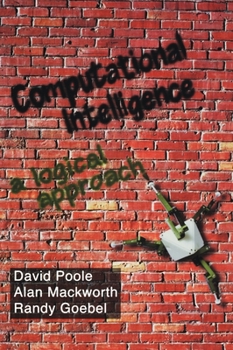Computational Intelligence: A Logical Approach
Select Format
Select Condition 
Book Overview
Computational Intelligence: A Logical Approach provides a unique and integrated introduction to artificial intelligence. It weaves a unifying theme--an intelligent agent acting in its environment-- through the core issues of AI, placing them into a coherent framework. Rather than giving a surface treatment of an overwhelming number of topics, it covers fundamental concepts in depth, providing a foundation on which students can build an understanding of modern AI. This logical approach clarifies and integrates representation and reasoning fundamentals, leading students from simple to complex ideas with clear motivation. The authors develop AI representation schemes and describe their uses for diverse applications, from autonomous robots to diagnostic assistants to infobots that find information in rich information sources. The authors' website (http: //www.cs.ubc.ca/spider/poole/ci.html) offers extensive support for the text, including source code, interactive Java scripts, various pedagogical aids, and an interactive environment for developing and debugging knowledge bases.
Ideal for upper-level undergraduate and introductory graduate courses in artificial intelligence, Computational Intelligence encourages students to explore, implement, and experiment with a series of progressively richer representations that capture the essential features of more and more demanding tasks and environments.
Ideal for upper-level undergraduate and introductory graduate courses in artificial intelligence, Computational Intelligence encourages students to explore, implement, and experiment with a series of progressively richer representations that capture the essential features of more and more demanding tasks and environments.
Format:Hardcover
Language:English
ISBN:0195102703
ISBN13:9780195102703
Release Date:January 1998
Publisher:Oxford University Press
Length:576 Pages
Weight:2.60 lbs.
Dimensions:1.5" x 7.3" x 10.3"
Customer Reviews
2 ratings
Good Book
Published by Thriftbooks.com User , 18 years ago
This book takes a logical approach to artificial intelligence and it does a good and comprehensive job. Some of the criticism that it focuses on logic is, therefore, unfounded.
Serves well as an introduction
Published by Thriftbooks.com User , 23 years ago
Everything in this book used to be classified as artificial intelligence, but the authors have chosen to call it computational intelligence, arguing that it is the computational aspects of the subject that they want to emphasize. The book is very well written, and students and those interested in A.I. research and development will find it a helpful step to more involved studies. The emphasis in the book is on intelligent agents, which the authors characterize in chapter one. Agents are viewed as black boxes that take in knowledge, past experiences, goals/values, and observations and output actions. They define what they call a representation and reasoning system consisting of a language to communicate to a computer, a methodology for giving meaning to this language, and a collection of procedures for computation. They also outline the three applications domains they will be developing in the book: an autonomous delivery robot, a diagnostic assistant, and an infobot. The authors expand upon the representation and reasoning system in chapter 2 in terms that are familiar from mathematical logic and computer science. A formal language, a semantics, and a proof procedure are the three essentials of an RRS. All of these elements are discussed in great detail, and concrete examples are given for all the main concepts. Readers without any background in logic may find the reading difficult, but with some effort it could be read profitably. The authors do a good job of presenting material that is usually delegated to texts on formal computer science. In chapter three, the authors show how representational knowledge can be used for domain representation, querying, and problem solving. This is done via an example of electrical house wiring and the PROLOG-astute reader will find the presentation very straightforward. But LISP programmers will also see its influence and the discussion on lists. An application is given in computational linguistics, namely that of definite clauses for context-free grammars. A discussion of searching is given in chapter 4, in the context of potential partial solutions to a problem, with the hope that these will truly be real solutions for the problem at hand. Graph searching, blind search strategies, heuristic searching, and refinements of these are all discussed with great clarity. And, because of their importance in applications, dynamic programming and constraint classification problems are overviewed, albeit very briefly. Chapter 5 turns to the topic of how to choose a representation langauge for knowledge. The authors detail the criteria for comparing different languages or logics in terms of expressiveness, worse-case complexity, and naturalness. Most important in this chapter is the discussion on qualitative versus quantitative representations. This is followed in chapter 6 by a discussion of the user interactions to a knowledge-based system in terms of a meta-interpreter that produces knowledge acquistion, debugging, etc.






